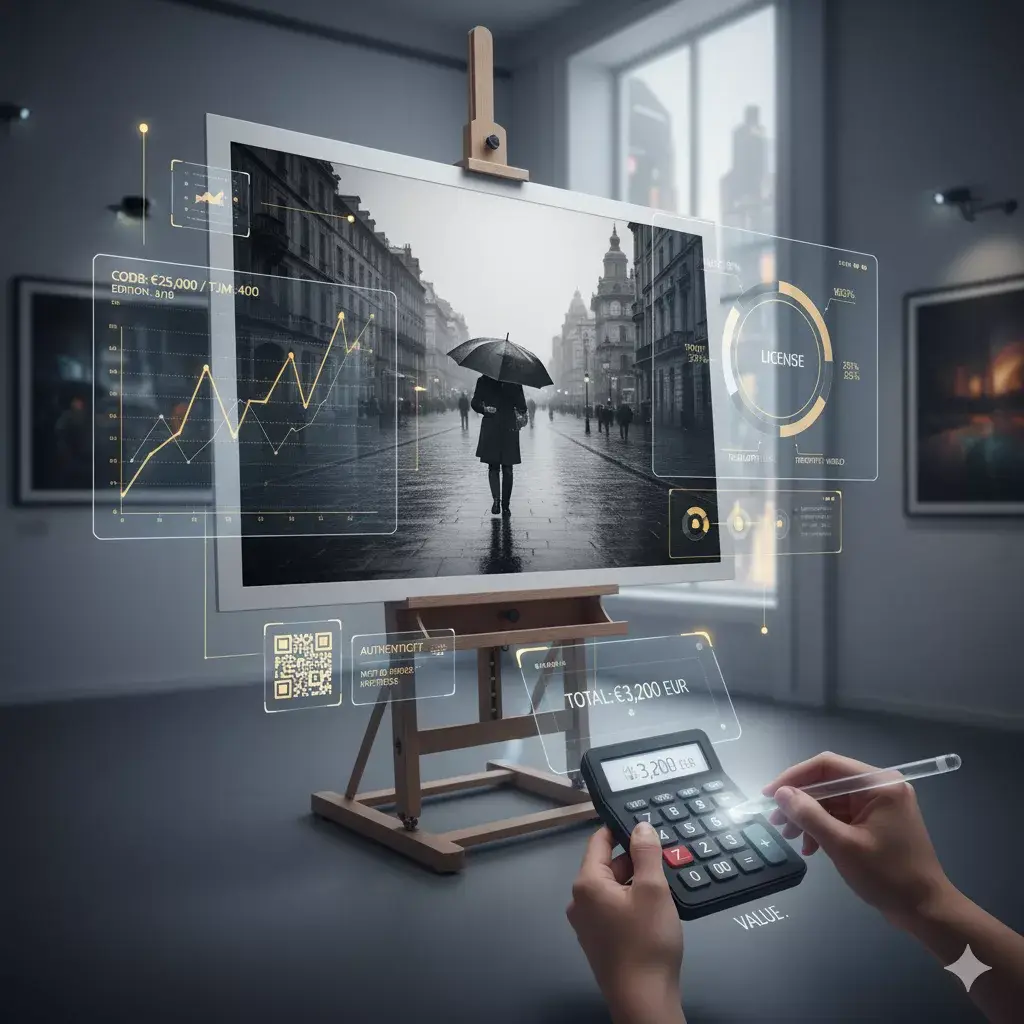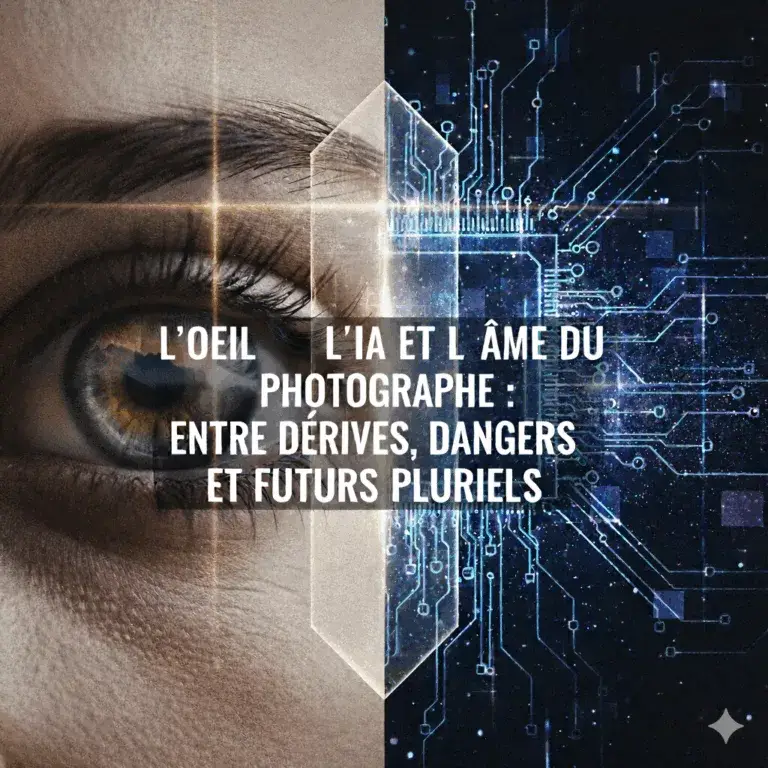
Introduction: It is the most complex and dreaded question for any photographer: “What is my image worth?”. In a saturated market where billions of photos are shared for free every day, and where generative AI produces technically perfect visuals on demand, pricing one’s work has become a balancing act. This requires moving beyond simple artistic value to embrace rigorous economic logic. Setting your prices is not just about calculating a cost; it is about defining your positioning, asserting your value, and ensuring the longevity of your career.
I. The Myth of the Artist: Embracing Commercial Value
The first obstacle is psychological. Many photographers struggle to financially quantify a work stemming from an intimate process, a “decisive moment,” or a creative effort. They sell an emotion and translate it into a number, which creates dissonance.
It is crucial to divide the analysis into two parts:
- Intrinsic Value (Artistic): It is subjective, emotional, and incalculable. This is what makes you an artist.
- Market Value (Commercial): It is objective, strategic, and must be calculated. This is what makes you a professional.
The selling price is not a reflection of your value as an artist, but the remuneration for a product and expertise within a commercial ecosystem.
II. Clarifying the Product: What Are You Really Selling?
A “photograph” is not a single product. Its price radically depends on its purpose. You do not sell the same “product” to an art collector and an advertising agency.
A. Fine Art Print (The “Fine Art” Market) You are selling a physical object. The client purchases ownership of this object (the print), but not the reproduction rights. Value is based on rarity, material quality, and the artist’s reputation.
B. Usage License (The Commercial/Editorial Market) You are selling permission. The client purchases neither the image nor its rights, but authorization to use it within a defined framework. This is the most common model for press, advertising, and web use.
C. Rights Transfer (The “Buyout”) You are selling the intellectual property (or a significant portion thereof). The client purchases the right to exploit the image (almost) as they see fit, often without time or medium limitations. This is the most expensive and riskiest option for the photographer.
III. The Unavoidable Foundation: The “Cost of Doing Business” (CODB)
Before considering profit, you must calculate the break-even point. This is the non-negotiable basis for any pricing. If your selling price is below your CODB, you are paying to work.
1. Annual Fixed Costs (Operating Expenses):
- Equipment (Depreciation): Spreading the cost of your camera bodies, lenses, computer over 3-5 years.
- Software: Subscriptions (Adobe Creative Cloud, Capture One, etc.).
- Insurance: Professional Liability, equipment insurance.
- Expenses (Studio/Office): Rent, electricity, internet.
- Marketing: Website, portfolio, advertising.
- Training: Courses, workshops.
- Taxes & Contributions: Taxes, social contributions (URSSAF in France, etc.).
2. Variable Costs (Directly linked to sales):
- For a Print: Printing cost (lab), framing, certificate of authenticity, packaging, shipping.
- For a License: Specific post-production time, file transfer fees.
3. Working Time (Your Salary): Calculate your desired Average Daily Rate (ADR). How many days per year do you expect to bill (not just work)? Example: (Annual Fixed Costs €10,000 + Desired Net Annual Salary €30,000) / 100 billable days = €400/day. This is your minimum ADR.
The Selling Price (Minimum) = (Variable Costs) + (ADR x Number of Working Days) + Margin (Profit).
IV. Strategy 1: Pricing Fine Art Prints
The art market is based on rarity and perception.
A. Open Edition
- What: Unnumbered, unsigned prints (or digitally signed).
- Price: Low. Volume-based model.
- Objective: Accessibility, dissemination, passive income (via print-on-demand platforms).
- Example: Decorative poster at €50.
B. Limited Edition This is the core of the “Fine Art” market. Rarity creates value.
- What: A fixed series of prints (e.g., 10, 30, 100), encompassing all formats and media. Each print is numbered (e.g., 3/10) and signed, often with a certificate.
- Pricing Strategy: The price MUST increase as the edition sells out.
- Prints 1-3/10: €500
- Prints 4-6/10: €750
- Prints 7-9/10: €1,200
- Print 10/10: €2,000
- Adjustment Factors:
- Format: The price increases exponentially with size. A 100x150cm print is not double the price of a 50x75cm print; it can be 4 to 5 times more expensive.
- Medium: A print on Hahnemühle paper under Diasec will cost more than a simple canvas print.
- Reputation: An emerging artist starts low to build their market. An established artist (exhibited in galleries) has a market value that justifies higher prices.
V. Strategy 2: Pricing Licenses (Commercial/Editorial)
Here, the value is not the object, but the audience the image will reach. A photo used for a global advertising campaign is worth infinitely more than the same photo used on a local blog.
We use scales (historically, those of the UPP in France, or calculators like Getty) based on 5 key criteria (the “D.A.T.E.S.”):
- Distribution (Media): Where will the image be seen? (Web, Print Media, Out-of-Home (OOH) Advertising, TV, Packaging…).
- Audience (Size): What is the size of the audience? (Magazine circulation, website traffic, advertising campaign size).
- Territory: Where will the image be distributed? (City, Region, Country, Europe, World).
- Exclusivity: Is the client the only one who can use this image? (Total exclusivity can double or triple the price).
- Duration: For how long? (1 month, 1 year, 5 years, Perpetuity).
License Models:
- Rights-Managed (RM): The price is custom-calculated according to the 5 criteria above. This is the most precise and profitable model for unique images.
- Royalty-Free (RF): The client pays a fixed price, often based on file size (resolution), and can use it multiple times. (Not to be confused with “free” or “copyright-free”).
VI. The Challenge of the Current Market (2025): AI and Saturation
The market has changed.
- The Impact of AI: Generative AI (Midjourney, DALL-E) has virtually destroyed the “microstock” market and the “generic” illustrative image market. Why buy a photo of a “smiling businessman” when you can generate it in 10 seconds?
- Saturation (Instagram): The abundance of high-quality (technical) images available for free for “inspiration” has devalued the perception of professional photography in the eyes of some clients.
The Strategic Response: Value no longer lies solely in the image, but in what AI cannot (yet) do:
- Authenticity and Proof: A photo of reality, a reportage, a portrait capturing a soul. The “proof of humanity” becomes a selling point.
- Narrative (Storytelling): The price includes the story behind the image. The process, the artist’s intention, the “making-of.”
- Curation and Vision: In an ocean of noise, a photographer’s ability to have a coherent and unique vision (their “style”) is what gains value.
- Certification (NFTs): Although the speculative NFT bubble has burst, the underlying technology (blockchain) remains a viable solution for certifying the authenticity and ownership of a digital edition, particularly relevant for native digital photography.
VII. Mistakes to Absolutely Avoid
- Pricing by Emotion: “This one took me 10 seconds to capture, so it’s worth less than the one that took me 3 days of scouting.” False. The client buys the result, not your effort.
- Inconsistent Pricing: Charging arbitrarily without an internal pricing structure destroys your credibility.
- Neglecting Contracts: A price must always be accompanied by a quote and an invoice detailing the rights granted precisely.
- The Race to the Bottom: Attempting to compete with amateurs or AI on price is commercial suicide. You cannot be cheaper than “free” or “$0.05.” The only solution is to justify a high price with superior value.
- Apologizing for Your Prices: Confidence is a sales tool. A price announced with assurance is perceived as fair. A price whispered with apologies invites negotiation.
Conclusion
Pricing your photographs in 2025 is a strategic act that forces the photographer to become an entrepreneur. It requires a rigorous calculation of costs (CODB), a clarification of the product (Print or License), and a keen understanding of the market (Reputation and Competition).
In the current context, value is shifting from the purely technical aspect of the image to the artist’s intention, story, and authenticity. Your price is not just a number; it is a declaration of your professional value in a world saturated with images.
This post is also available in:
French

